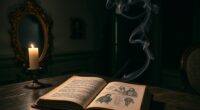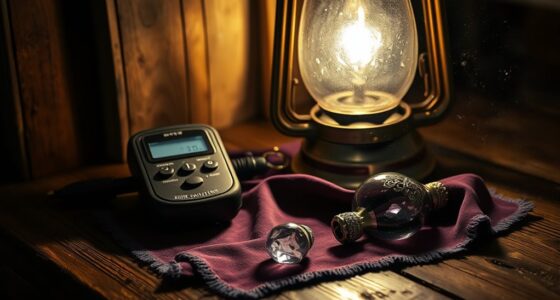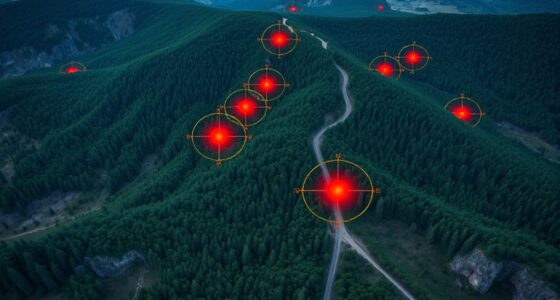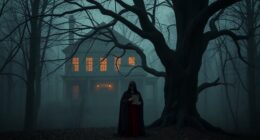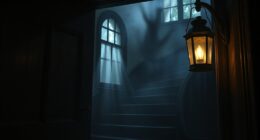When it comes to debunking common paranormal claims, it’s important to recognize that not all ghosts are malevolent, and activity can occur at any time, not just at night. Cold spots often have logical explanations, and orbs in photos are usually just dust or insects. Ouija boards don’t always summon evil spirits, and haunted locations aren’t necessarily old. Skepticism can be healthy, but it needs to be balanced with open-mindedness. Keep exploring to uncover the nuances behind these misconceptions.
Key Takeaways
- Many spirits are benign or seek to communicate rather than harm, challenging the common belief that all spirits are malevolent.
- Paranormal activity can occur at any time, not just at night, as numerous daytime ghost sightings have been reported.
- Orbs in photographs are often misidentified; common explanations include dust, pollen, and insects rather than supernatural entities.
- Historical context does not guarantee hauntings, as many old buildings lack documented paranormal activity despite their rich histories.
- A balanced approach that combines skepticism and open-mindedness allows for a deeper understanding of paranormal claims and enhances investigative efforts.
Myth 1: All Ghosts Are Malevolent

Although many films and stories portray ghosts as purely malevolent beings, this view doesn’t reflect the full spectrum of paranormal experiences.
In reality, many ghost sightings involve spirits that are peaceful or even benevolent. These encounters often reveal that some spirits may seek to convey messages rather than cause harm.
Historical records show that, just like living individuals, spirits can exhibit a range of personalities. If you believe in ghosts, it’s essential to challenge the misconception that all spirits are hostile.
Myth 2: Paranormal Activity Only Happens at Night
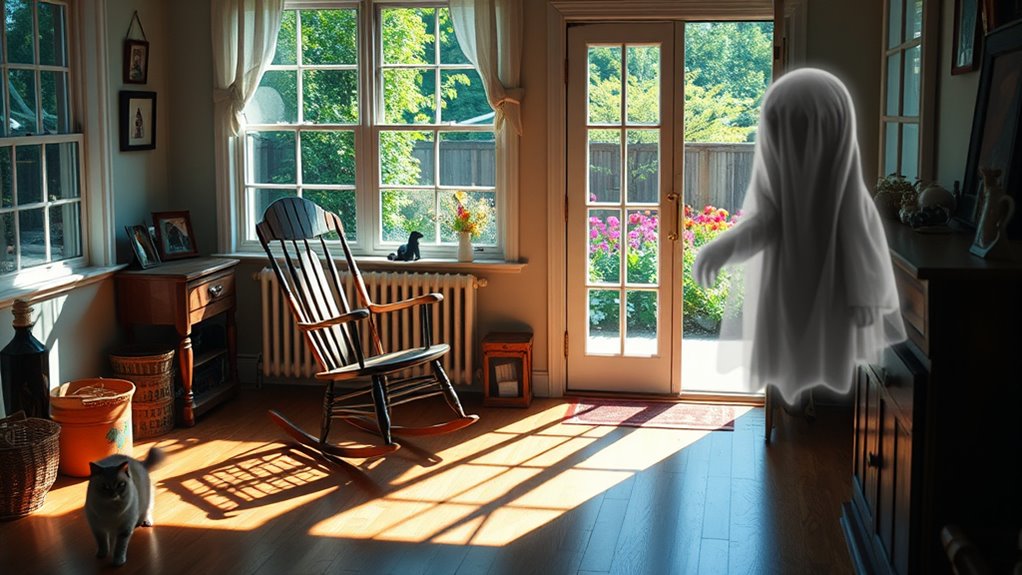
Many people believe that paranormal activity only occurs at night, but this misconception overlooks the countless reports of supernatural events happening during daylight hours. The idea stems from cultural fears of darkness rather than actual evidence.
In reality, you might encounter paranormal phenomena anytime, such as:
- Daytime ghost sightings reported in homes and historical sites.
- Unexplained noises heard in broad daylight.
- Objects moving without cause during the day.
- Sudden feelings of unease in well-lit areas.
Investigators often prefer night for reduced noise, but compelling experiences happen in sunlight, too.
Scientific explanations can often clarify these reports, but dismissing daytime phenomena limits understanding of the supernatural.
Myth 3: Cold Spots Are Always Paranormal
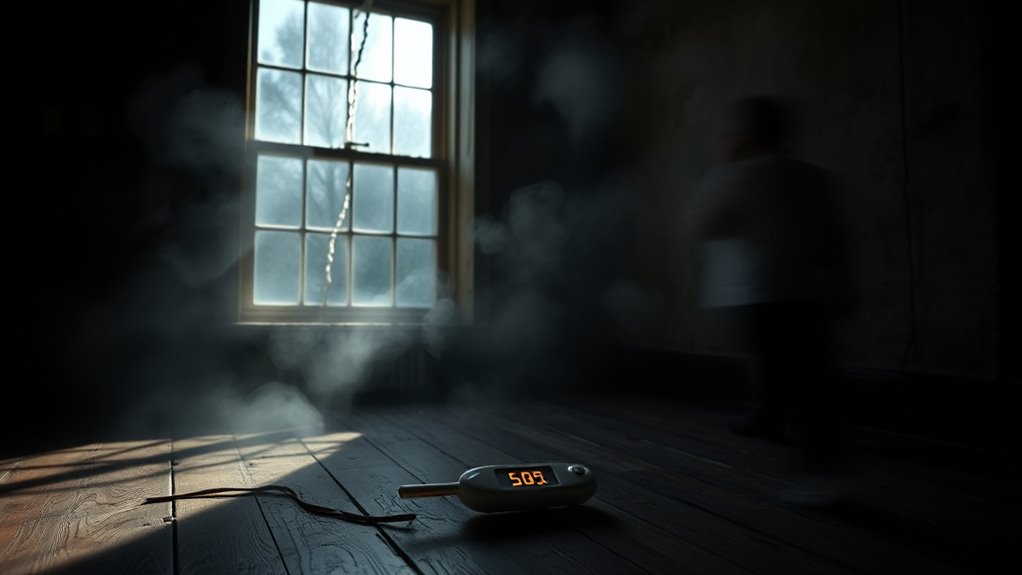
While cold spots are often seen as a clear sign of paranormal activity, they’re not always what they seem. Many people link these temperature drops to spirits drawing energy from the environment, but logical explanations often exist.
Before jumping to conclusions, consider mundane factors like drafts, ventilation issues, or humidity changes that can create cold spots. Scientific studies show that sudden temperature fluctuations result from these environmental factors, not ghostly encounters.
Consider everyday factors like drafts or humidity changes before attributing cold spots to paranormal activity.
The association between cold spots and the supernatural is largely anecdotal, lacking consistent empirical evidence. It’s essential to critically analyze cold spots and not automatically attribute them to unexplained phenomena.
A thorough investigation will help clarify whether you’re dealing with something paranormal or just ordinary environmental changes.
Myth 4: Orbs In Photos Are Spirits

When you see orbs in photographs, it’s easy to jump to the conclusion that they’re spirits or supernatural entities.
However, most of these orbs have mundane explanations.
Consider these factors:
- Dust: Tiny particles floating in the air can easily reflect light, creating orbs.
- Pollen: Seasonal changes often lead to increased pollen, which can appear as orbs in photos.
- Insects: Bugs flying close to the camera can create orb-like images.
- Moisture: Water droplets in the air can scatter light, forming orbs.
The rise of orb sightings among ghost hunters is often fueled by psychological factors, leading to misconceptions.
Myth 5: Ouija Boards Always Summon EVIL Spirits
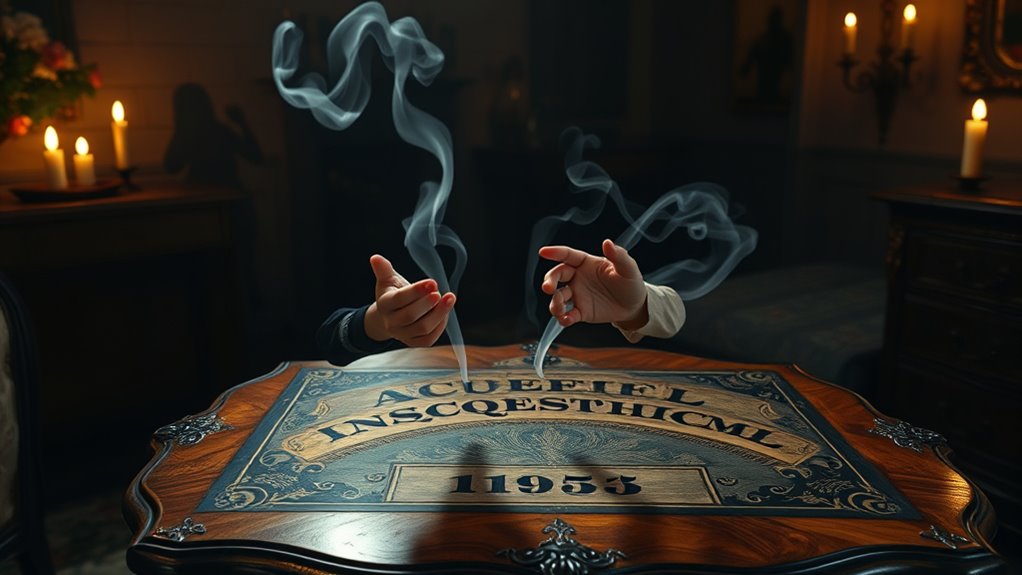
Many people believe that Ouija boards are guaranteed to summon evil spirits, but that’s a misconception shaped by movies and folklore.
Your intentions and mindset play an essential role in the experience, often leading to benign interactions instead. By approaching the board with respect and caution, you can greatly influence what happens during your session.
Misconceptions About Ouija Boards
Although popular culture often portrays Ouija boards as gateways to malevolent spirits, this notion is largely a myth.
Here are some key points to reflect upon regarding misconceptions about these paranormal tools:
- Ouija boards reflect the users’ energy and intentions, not inherently summon evil spirits.
- Many individuals have positive experiences using them without negative effects.
- Cultural narratives and sensationalized media often skew perceptions of Ouija boards.
- Respectful handling and a cautious approach can mitigate perceived risks.
Understanding these factors can help you navigate the world of Ouija boards more accurately and safely.
It’s important to separate fact from fiction and approach these sessions with an open mind and positive intention.
User Intentions Matter
While it’s common to hear that Ouija boards always summon evil spirits, this belief overlooks an essential factor: user intentions.
User intentions matter greatly in determining the outcome of your experience. Many users report no negative effects, suggesting that the psychology behind your mindset plays a critical role. If you approach the board with respect and caution, you’re more likely to have a positive interaction.
Cultural misconceptions and sensationalized stories have fueled fears, overshadowing the potential for benign experiences. Ultimately, your held beliefs and expectations shape what you encounter while using a Ouija board, rather than any inherent malevolence of the board itself.
Myth 6: Paranormal Phenomena Can Be Easily Proven
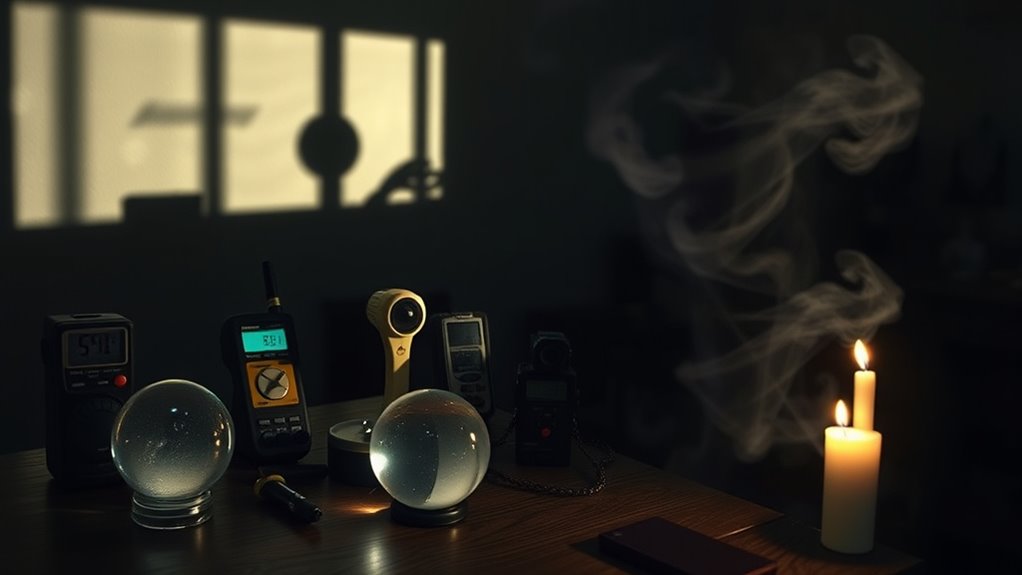
You might think proving paranormal phenomena is straightforward, but it’s far from easy.
The scientific community demands replicable and objective evidence, which many personal experiences simply can’t provide.
As you’ll see, the challenges of validating these claims make it a complex endeavor.
Scientific Validation Challenges
Scientific validation of paranormal phenomena is fraught with challenges, primarily because the scientific community demands replicable results and rigorous methodologies for any claims to be accepted.
Here are some key hurdles:
- Anecdotal Evidence: Personal stories lack controlled conditions and are often subjective.
- Natural Explanations: Many reported experiences can be attributed to psychological factors or environmental influences.
- Absence of Physical Evidence: The lack of tangible proof, like ghosts, complicates these claims.
- Complex Investigations: Systematic approaches are necessary to rule out natural explanations before considering supernatural ones.
Without meeting these standards, scientific validation remains elusive, leaving paranormal claims largely unproven and open to skepticism.
Subjective Experience Limitations
Although many people believe that paranormal phenomena can be easily proven through personal experiences, the reality is much more complex. The subjective experience of individuals plays a significant role, often leading to widely varying perceptions. Here’s how subjective experiences shape the understanding of paranormal claims:
| Aspect | Subjective Experience | Anecdotal Evidence |
|---|---|---|
| Validation | Lacks replicability | Insufficient for proof |
| Individual Perception | Varies greatly | Often emotionally driven |
| Scientific Approach | Requires rigorous methods | No systematic evaluation |
While anecdotal evidence can be compelling, it doesn’t meet the standards of scientific scrutiny. The absence of concrete proof continues to fuel skepticism in the scientific community regarding these paranormal claims.
Myth 7: Haunted Locations Are Always Old
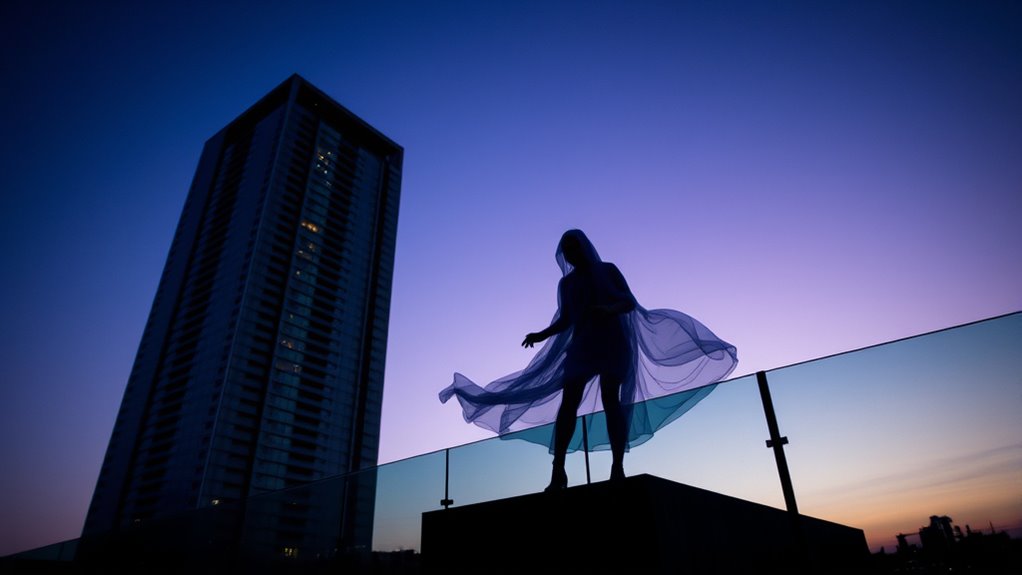
While many people assume that only old buildings can be haunted, this belief is a common misconception.
In reality, hauntings can occur in modern constructions, too. Here are some reasons why:
- New sites may be built on historically significant land.
- Many newer structures report unexplained phenomena.
- Historical context doesn’t guarantee a ghostly presence.
- Old buildings often remain free from any haunting claims.
Myth 8: Skeptics Are Always Right

Many believe that skeptics hold the ultimate truth when it comes to paranormal claims, but that assumption can be misleading. While skepticism plays a crucial role in questioning extraordinary claims, it doesn’t guarantee infallibility.
Skeptics often rely on empirical evidence, which may not always apply to supernatural phenomena. Their conclusions can be clouded by biases or a lack of understanding. Notably, not all skeptics dismiss paranormal experiences outright; some embrace open-mindedness and advocate for thorough investigations.
A balanced approach that combines skepticism with open-mindedness fosters a deeper understanding of these complex claims. Ultimately, both skeptics and believers can misinterpret evidence, so it’s essential to remain critical yet receptive to explore the unknown.
Frequently Asked Questions
Is There Any Scientific Evidence of Paranormal Activity?
You won’t find any scientific evidence supporting paranormal activity.
While many claim to experience ghostly encounters, researchers have yet to uncover credible proof. Extraordinary claims require extraordinary evidence, and so far, anecdotal accounts don’t hold up under scrutiny.
Factors like low-frequency sounds and visual illusions often explain these experiences.
Did People Think Paranormal Activity Was Real?
Yes, many people have believed in paranormal activity throughout history.
You’ll find that, even today, a significant portion of Americans accept supernatural phenomena as real. Anecdotal evidence, like individual ghost sightings, fuels this belief.
Influential figures, such as Winston Churchill, have shared their experiences, further encouraging the notion.
Cultural backgrounds and psychological factors also play a role in how people interpret unexplained events, leading to a diverse range of beliefs about what’s possible.
How to Tell if Something Paranormal Is Happening?
To tell if something paranormal is happening, start by ruling out natural explanations like drafts or wildlife.
Pay attention to your surroundings; low-light or emotionally charged situations can skew perceptions. Use common sense and critical thinking to distinguish between what you feel and what can be proven.
Document your experience, noting the date, time, and conditions. Be cautious of anecdotal evidence and look for consistent patterns before jumping to conclusions about paranormal activity.
What Are the Alternative Explanations for Ghosts?
You might find it curious how often what seems like a ghostly encounter aligns with common environmental factors.
Drafts and humidity changes can create unsettling sensations, while low-frequency sounds might trigger feelings of dread.
Your own emotions and poor lighting can distort perceptions, leading you to misinterpret ordinary noises—like creaking floors—as paranormal.
Even dust in the air can turn ordinary photographs into eerie images, making you question reality more than you should.
Conclusion
In the world of the paranormal, it’s easy to get swept away by myths and misconceptions. Remember, “Curiosity killed the cat, but satisfaction brought it back.” By questioning these common beliefs, you can find clarity and a deeper understanding of the unknown. The truth often lies in the shadows, waiting for a skeptical mind like yours to shine a light on it. Embrace the mystery, but don’t let it cloud your judgment. Stay curious and informed!

